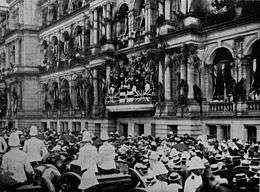Treasury Building, Brisbane
| Treasury Building, Brisbane | |
|---|---|
 Treasury Building nowadays hosting the Treasury Casino | |
| Alternative names | The Treasury |
| General information | |
| Architectural style | Classical |
| Location | Brisbane Square, Brisbane |
| Address | 21 Queen Street (on the block bounded by Queen Street, George Street, Elizabeth Street, and William Street), Brisbane city, Queensland |
| Current tenants | Treasury Casino owned by Tabcorp |
| Inaugurated | 8 April 1930 |
| Owner | Government of Queensland |
| Design and construction | |
| Architecture firm | John James Clark |
The former Queensland Government Treasury Building is a heritage-listed public administration building located at 21 Queen Street, Brisbane, Queensland, Australia. It is currently occupied by the Treasury Casino owned by Star Entertainment Group.
Geography
The building is located at North Quay, near the northern end of Victoria Bridge. Although officially fronting on Queen Street, the building occupies an entire city block surrounded by Queen Street, George Street, Elizabeth Street and William Street. The Elizabeth Street frontage is opposite the Queens Gardens. In the 1890s and early 1900s the imposing Treasury Building served as a symbol of self-government and as a focus for celebratory and patriotic displays.
History



Prior to the Treasury Building's construction the site housed a two-storey military barracks.[1] In 1901, the proclamation of the federation of the Australian Commonwealth was read by the Governor of Queensland Baron Lamington from a balcony on the William Street elevation.[1][2]
The Queensland Government Cabinet met in the building until the 1905, when the Premier's Department moved into the Executive Building (subsequently known as the Lands Administration Building) in George Street. Subsequently, more departments moved out and the Treasury Building, along with the Lands Administration Building were sold and now form the Treasury Casino.
Construction
The Treasury was erected in three stages between 1886 and 1928. In 1883, a design competition for a two-storeyed building was won by Melbourne architects Grainger and D'Ebro. However this design was never used as the Queensland Colonial Architect, John James Clark, argued that the site warranted a four-storeyed complex built in stages.. Clark's own neo-Italianate design, entered in the competition prior to his appointment, was used. Clarke is also known for his earlier work on the Old Treasury Building in Melbourne[1] and other public works in Perth.
The first stage of the building to be completed was the William Street and part of the Queen St frontages and was built by the Phippard Brothers.[1] When completed in September 1889, the new building was occupied by the Premier, Colonial Secretary, Registrar-General, Treasury, Mines, Works, Police and Auditor-General. The construction of stage two, which completed the Elizabeth Street section, was commenced almost immediately and was completed by February 1893. This new wing was occupied by the Registrar of Titles, Justice, Works, Public Instruction and the State Savings Bank. The final stage of construction was started in 1922 and the Queen and George street frontages were officially opened in 1928, providing additional space for the existing occupants. In 1961, a five-storey annexe was built in the courtyard.[2]
Design
The building is faced with sandstone ashlar except for the inner walls of the arcade. These brick walls are finished with lined and unpainted render imitating ashlar. Each phase of construction has used a different type of sandstone. A colour difference is discernible between the Highfields stone used for the first phase of construction, and the Helidon sandstones used for the later stages.[2] The external walls sit on a porphyry plinth.
The design was proposed by Australian Architect John James Clark. In that time the treasury building would be home to many government authorities such as the Registrar-General, Premier, Treasury, Security, Mines, and the Police. However, from 1989 the Registrar-General was the sole occupant of the building, as other members of the government had moved to newer, more modern quarters. The building is an important symbol of the development and progress of Brisbane’s political history. The architectural style can be compared to that of the 16th-century Italian architecture.(EPA 2006) It has an accomplished design, detailing both exterior and interior, materials such as sandstone and boasts exquisite workmanship. The Queen Street entrance features a grand staircase.[2]
Treasury Casino
The courtyard at the centre of the building was roofed over for the conversion.[2] Since 1995, the refurbished building has housed the Conrad Treasury Casino, contrasting the once political orientation of the building to one full of entertainment. It is home to two bars, five restaurants, and eight function rooms.
Heritage listing
The Treasury Building was listed on the Queensland Heritage Register in 1992.[3]
See also
References
- 1 2 3 4 Hadwen, Ian; Janet Hogan; Carolyn Nolan (2005). Brisbane's historic North Bank 1825 - 2005. Brisbane: Royal Historical Society of Queensland. p. 74. ISBN 0-9757615-0-1.
- 1 2 3 4 5 Gregory, Helen; Dianne Mclay (2010). Building Brisbane's History: Structure, Sculptures, Stories and Secrets. Warriewood, New South Wales: Woodslane Press. pp. 50–52. ISBN 9781921606199.
- ↑ "Treasury Building (entry 600143)". Queensland Heritage Register. Queensland Heritage Council. Retrieved 13 July 2015.
External links
 Media related to Treasury Building, Brisbane at Wikimedia Commons
Media related to Treasury Building, Brisbane at Wikimedia Commons
Coordinates: 27°28′18″S 153°01′25″E / 27.471696°S 153.023624°E